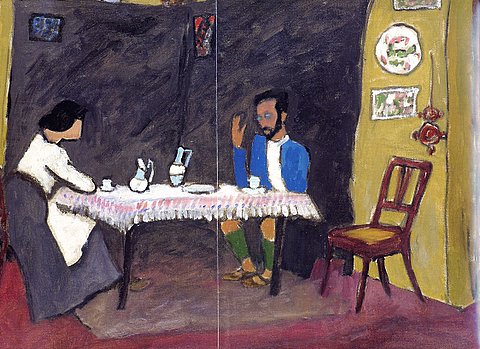Painter Erma Bossi was born 11 June 1882 in Pola, a small village near Trieste. An artisitic prodigy as a teen, she was sent to the Women’s Art Academy in Munich at the turn of the century, where she soon met Gabriele Münter, who would later paint a portrait of her friend and Wassily Kandinsky when Bossi visited the couple in Murnau. In 1909 Bossi joined the Neue Künstlervereinigung München (NKVM), which had just been founded and which showed its members’ work at the famous Galerie Thannhauser. This artists’ association included among its members as Kandinsky and Münter, Marianne von Werefkin, Franz Marc, Moissey Kogan, Karl Hofer and others.
At the outbreak of World War I, Bossi moved to Paris, eventually settling in Milan in 1918. She remained in contact with the Parisian avant-garde, showing her paintings at the annual exhibitions mounted by the Salons des Indépendants and Salons d’Automne. In Milan she showed work at the novecento exhibitions of 1926 and 1929. Bossi was one of only a few women to participate in the 1930 and 1935 Venice Biennales, her large, simplified forms in festive colors having become a template of the international avant-garde.
Then something rather unusual happened, given Bossi’s earlier utopian background: She began to align her philosophy and work with the later incarnations of the Futurists, and to associate with Italian fascist politics. Between 1929 and 1939, Bossi exhibited her paintings – which by this time had become stylized portraits and still lives – in galleries in Milan and Venice. In a further mystery – as few documents remain from Bossi’s estate – in 1939, after winning the Bergamo Prize, Bossi suddenly disappeared. In 1952 her death was recorded at the Cesano Boscone Catholic Care Institute in Milan.
Reference: Irit Rogoff. “Tiny anguishes: reflections on Nagging, scholastic Embarrassment, and Feminist Art History,” in differences: A Journal of Feminist Cultural Studies, Fall1992, Vol.4(3), pp. 38-66.
Erma Bossi, 1905, Archivio Carla Pellegrini, Milan.
Ragazzo (Giovane) in costume spagnolo, 1930. Ketterer Kunst, Stuttgart.
Restaurant am Hof, 1919. Ketterer Kunst, Stuttgart.
Stillleben mit Blumenvase und Äpfeln, c. 1910. Ketterer Kunst, Stuttgart.
Nature morte à la carafe, 1912. Ketterer Kunst, Stuttgart.
Gabriele Münter. Kandinsky und Erma Bossi am Tisch, 1909. Princeton University Art Museum.
Further Reading: Gillian Perry. Women Artists and the Parisian Avant-Garde. Manchester: Manchester University Press, 1995.
Matthew Affron and Mark Antliff. Fascist Visions: Art and Ideology in France and Italy. Princeton, N.J.: Princeton University Press, 1997.







Hi, I am interested to know if anyone has contact details for the estate of Erma Bossi, thank you.
Hi Emma,
We don’t have any details. However, I’ll leave this thread open for responses.
All best wishes